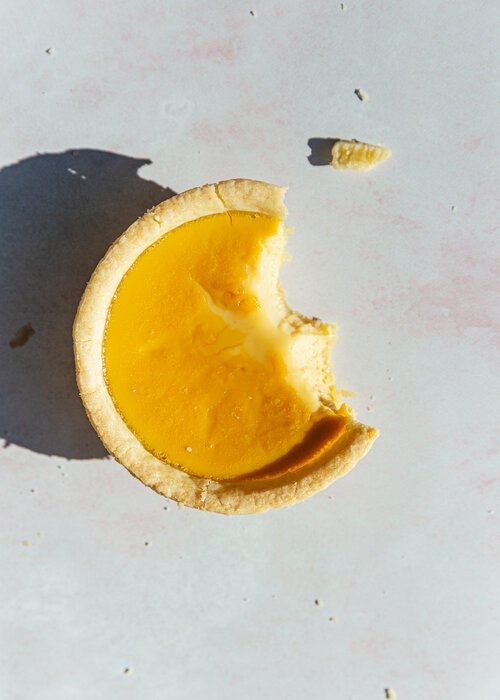This pan-fried steamed bun recipe is delicious and easily made with a frying pan. Steamers are not required! They are perfectly crispy, juicy, and to be enjoyed straight out of the pan.
In Taiwan — we call these “Water Fried Buns 水煎包“. Vendors fry these by the batch and serve them piping hot with chili vinegar sauce drizzled all over. In Shanghai, you’ll find smaller versions of these buns called “Shanghai pan-fried bao 上海生煎包“. They are world-renown and ultra delicious.
This recipe uses the same filling as the Pork Tomato Steamed Bun. I halved it for smaller portions. You’ll need cornstarch slurry and a decent-sized pan, as they’ll crisp up with more space. Fry in batches if you need. If you’re using a cast iron pan, keep an eye on the heat as the bun bottoms can burn very quickly.
Pleating the buns
Fluffy proofed buns, ready to be fried
Perfectly juicy and golden-brown buns.
Pork and Tomato Steamed Buns
Makes 8 buns, serves 2 people
INGREDIENTS
Meat Filling (Or use a filling of choice)
1/2 lb (225 g) lean ground pork
1 medium (100 grams) tomato
1 tbsp soy sauce
1/2 tbsp (5 g) ginger, peeled and finely minced
1/2 tsp Sichuan peppercorn powder
1/2 tbsp salt
2 spring onions, chopped
1 tbsp sesame oil
1/2 Half Portion of Steamed Bun Dough
Cornstarch slurry
1 tsp cornstarch
1/4 cup water
1 tsp oil
Garnish
Black sesame seeds and chopped green onion (optional)
INSTRUCTIONS
Make your dough: I like to make the filling while I wait for the dough to rise. You can also prep the filling ahead to save time.
Prep the tomato: Over high heat, bring a small pot of water to boil. Drop in the tomato and stir gently. Cook for 2 minutes, drain, and let cool. Peel the skins off the tomato, squeezing as much tomato juice as you can into a separate bowl while reserving the pulp. Finely chop the tomato pulp. Set the juice and pulp aside.
Mixing the mince: Add the meat to a large mixing bowl. Gradually add in the tomato juice, stirring with chopsticks until well incorporated. The meat should start to look like a paste. Add in the soy sauce, pepper powder, ginger, green onion, salt, and tomato pulp, stirring continuously. Lastly, add in the sesame oil and mix. The oil will prevent the mixture from becoming too watery. Set the filling aside until ready to use.
Make the cornstarch slurry: Add the cornstarch, water and oil to a small bowl. Stir to combine and set aside.
Prep your frying pan: Generously oil the bottom of a frying pan. This is where you’ll place the pleated buns for proofing.
Rolling the wrapper: Make half of this steamed bun dough recipe. Flour your surface and flatten a morsel of dough with your palm. Using a rolling pin, roll the dough from the edge towards the center, without actually rolling the center of the dough. You want a thick center and thin edges on your wrapper. The wrapper should be 4-5 inches in diameter. Cover the wrappers while you work.
Pleating the Bun: Place the wrapper in one hand and scoop a heaping tablespoon of filling into the center. The filling should weigh around 30-40 grams. For beginners, start with a minimal amount of filling to help the pleating process. Flatten the filling with a spoon and follow the steps below. Swap hands if you are left-handed and refer to the moving image above:
- With your right forefinger and thumb, firmly pinch an edge of the wrapper to make the first fold.
- Continue pinching folds with your right index finger and thumb. Rotate the wrapper with your left hand as you go, pinching until the whole bun is pleated. While pleating, use your left thumb to press down the filling so the dough comes over the filling.
- Seal the bun with a series of pinches to form the pointy top of the bun. Repeat with the remaining dough and filling. Place the buns in the frying pan, allowing 1 inch of space between the buns.Second Rising: Cover the frying pan and cook over low heat for 2-3 minutes. The bottom of the pan should be warm and not burning to the touch. Let the buns sit for 15-20 minutes. The 2nd rising will allow the buns to be pillowy and soft. You’ll know the buns are ready when they have expanded in size and are fluffy and light to the touch.
Fry the buns: Fry the buns over medium-low heat, uncovered for 6-7 minutes or until crispy and golden on the bottom. Lift and check the bottoms periodically with a fork. Stir the cornstarch slurry and pour it into the pan, avoiding the buns if possible. Cover and cook for 8 minutes. Let sit for 5 minutes before taking the lid off. This will ensure your buns do not deflate with the quick temperature change.
Garnish with sesame seeds or green onions. Serve immediately, or let cool and refrigerate. These buns are best fresh and will keep in the freezer for 2 months.
Cooking Tips:
If you are making the filling ahead, reserve the spring onion and sesame oil until you are ready to pleat the buns. The raw filling will keep in the fridge for 2-3 days.
Alternatively, use canned peeled tomatoes.
For beginners, start with a minimal amount of filling to help the pleating process. No one starts out with good-looking buns so practice makes perfect.
Use any leftover meat filling for dumplings or meatballs.
These buns are best enjoyed fresh as the dough will absorb the meat juices over time.











